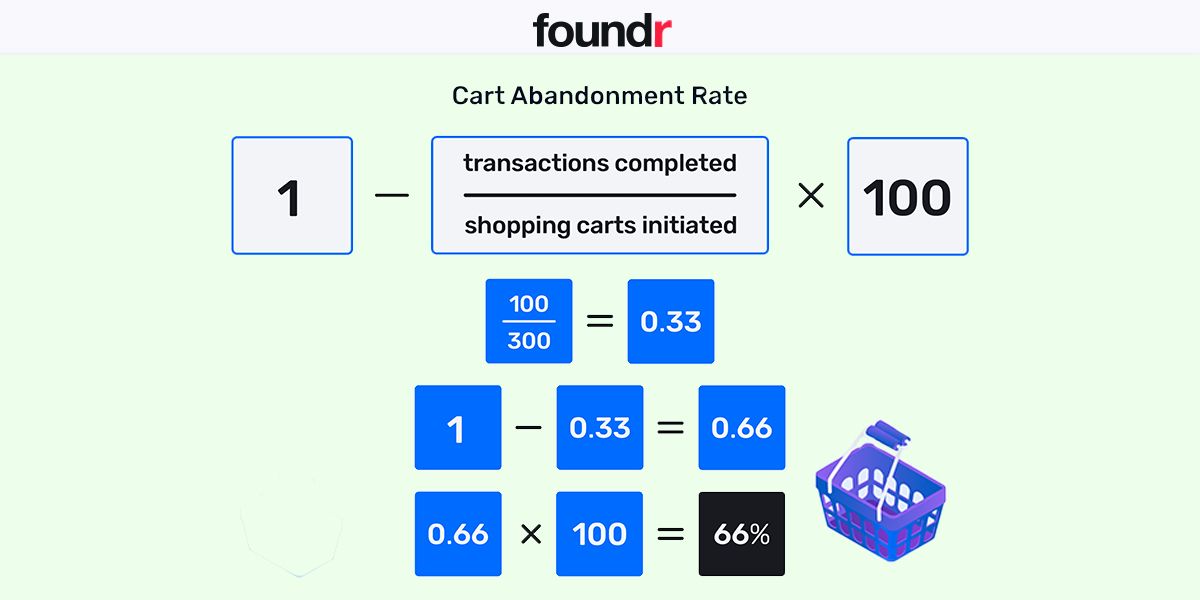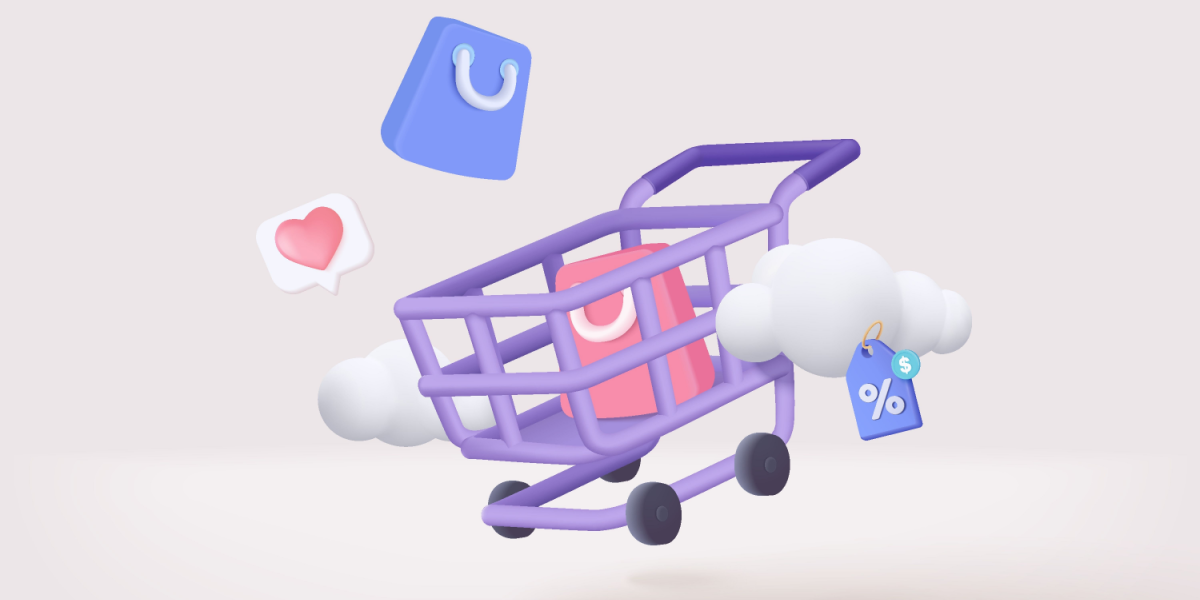Digital shopping cart abandonment is a challenge that every ecommerce retailer has to face, but it can be incredibly frustrating to stare at data showing you a bunch of abandoned carts without knowing what to do about it.
We’ll walk you through everything you need to know about cart abandonment: what it is, what the average shopping cart abandonment rate typically is, common causes of abandoned carts, and ultimately, what you can adjust to increase your conversion rate.
Table of Contents
What Is Shopping Cart Abandonment?
How to Calculate Your Shopping Cart Abandonment Rate
7 Causes of Shopping Cart Abandonment
16 Ways to Fix Shopping Cart Abandonment
What Is Shopping Cart Abandonment?
Shopping cart abandonment is when a prospective customer begins the checkout process but does not complete it. Anyone who enters the shopping cart but does not complete the transaction is considered a cart abandoner.
Cart abandonment is a problem for retailers for two main reasons. First, you’ve lost a sale. The minute someone abandons their cart, you’ve lost the revenue you’d have earned if they’d completed a sale. In addition to that lost revenue, you have to contend with the increased costs associated with retargeting and marketing to cart abandoners.
Don’t Skip: Customer Retention Is More Important Than Leads. Here’s Why.
How to Calculate Your Shopping Cart Abandonment Rate
Whether or not shopping cart abandonment is an issue for your company depends on how much it’s happening compared to the number of sales you’re actually making. This is known as your shopping cart abandonment rate.
To calculate your shopping cart abandonment rate, you take the total number of completed transactions and divide it by the total number of initiated transactions; the result is expressed as a percentage rate.

7 Common Causes of Shopping Cart Abandonment
Unexpected costs, like shipping, delivery, and tax, are often primary drivers of cart abandonment, according to Karl Boehm, SEO Manager at National Business Furniture. Boehm says, “Those fees might push the price past the budget, or they might just feel bad—when shipping is baked into the price, it seems like a slightly more valuable item that also comes with a bonus of free shipping. It’s a psychological thing.”
The secondary primary cause of cart abandonment is an overly complicated checkout process. And what counts as “overly complicated” is actually a lot simpler than you might initially think. “Every time the users have to click their mouse or scroll down, a significant chunk of them just give up,” Boehm says.
Of course, there will always be items that have a natural tendency towards card abandonment. If a product is particularly expensive or requires a lot of consideration, abandonment is often a part of the customer journey, according to Boehm. A customer is unlikely to purchase a sofa the first time they see it, for example. An online shopper is more likely to place the sofa in their cart as an expression of interest and come back to it for more consideration. In cases like this, retailers will likely have to remarket to the customer with some combination of cart abandonment emails or retargeted ads.
The following 7 issues are the most common reasons an online shopper might abandon their cart before a completed purchase.
- Technical Issues: If your website or checkout process has technical issues, it’s going to drive abandonment. “Anything overburdensome, confusing, surprising, or slow to load will drive people away,” Boehm says.
- Your Checkout Process Is Too Complicated: If customers have to enter more information than they really need to, or if the data-entry process is too complicated, they’re less likely to complete the transaction. For example, look at how data validation affects the checkout experience. “You should also validate the user’s inputs after they click away from each input field. Otherwise, your website will constantly create big red warnings that ‘A’ is not a name or ‘9’ is not a phone number. In the same vein, you also don’t want to wait until they click “next” to tell them their info is wrong,” Boehm explains.
- You Don’t Have Enough Payment Options: Another reason that shoppers might not complete a transaction is that you don’t accept the payment method they want to use. They might prefer to use a specific credit card, or if they don’t have their credit card handy, they might want to use an option like ShopPay or PayPal.
- Your Shipping Costs Are Too High: Shipping costs are a consistent cause of abandonment for some ecommerce retailers. If your shipping costs are too high or if they come as a surprise to the customer, this can lead to lost sales.
- The Price of the Product Is Too High: Another possible reason could be that your product prices are too high. It’s pretty common now for online shoppers to price check before completing a transaction. If they find your product somewhere else for cheaper, that might be the reason they left their online shopping cart before purchasing.
- The Customer Wasn’t Ready to Convert: Your customer might have just been browsing, either because the product is high-cost, requires a good deal of consideration, or because they’re at the beginning of the sales funnel. The latter reason is common for potential customers who come to your site via social media, who might have just seen your product for the first time through a targeted ad.
- You Don’t Have Enough Brand Trust: Yeah, this one hurts to hear, but it’s possible that customers aren’t converting because they don’t trust your brand. That might mean that they just don’t know who you are, or it could mean that there’s a negative perception of your brand that’s preventing customers from converting.
16 Ways to Fix Shopping Cart Abandonment
Before you do anything else, you need to identify where abandonment is happening in your checkout process. Boehm says, “Find out where people are leaving. Google Analytics and other tools can show you how many people reach each page, and you can focus on the worst parts of your cart.” Ready to turn shopping cart abandonment into shopping cart recovery? Try these 16 proven strategies to overcome abandonment and drive online sales.
- Fix Technical Issues: Fix any and all technical issues that might be negatively impacting your customer experience. If you don’t have the skill set to do so and you don’t have someone on your team that does, it can be worth hiring a web developer to help fix your technical issues.
- Streamline Your Checkout Process: Only require what you absolutely have to. Make the rest of the customer data you’d like to collect optional. “If someone doesn’t want to tell you their company name or where they found you, just take their money anyway,” Boehm says.
- Optimize Your Checkout Process for Mobile Shopping: As more and more shopping is done on mobile devices, you need a checkout process that works just as well on mobile. If you designed a desktop-first checkout experience, it might be worth putting some development resources into your mobile experience. To determine if this is worthwhile for you, look at your cart abandonment stats. If your mobile cart abandonment rates are substantially higher than your desktop cart abandonment rates, that’s an indication that your mobile experience needs work. Data and validation provide essential insights as you make changes to your mobile checkout experience. Customer focus groups can point you to common customer pain points, and UX testing can validate your changes, ensuring that any adjustments you make improve the checkout experience without inadvertently creating new problems.
- Create a Guest Checkout Option: Creating a guest option is a savvy way to stave off checkout abandonment for shoppers who don’t want to create an account either for privacy concerns or out of convenience.
- Increase Your Payment Options: If you’ve got a lot of abandoned shopping carts because you don’t offer enough payment options, you can easily turn your potential customers into converted customers by offering more options. Added payment options can come with increased fees, but it’s worth looking at the average value of each abandoned cart. With more checkout options available, there’s a higher likelihood a customer will convert.
- Reduce Shipping Fees: Are shipping fees leading to a steep dropoff on your checkout page? If you’ve got wiggle room on your shipping costs, you might consider reducing shipping fees. Retail giants often offer “free shipping,” which can be difficult to compete with for smaller retailers, but you might be able to offer free or reduced shipping over a certain purchase amount. This turns your negative into a positive that can be marketed on your e-commerce site, potentially leading to an increase in your average order volume.
- Communicate Shipping Costs Up-Front: If you can’t reduce shipping costs, communicate them early and often. That way, customers can accurately predict the total cost of the purchase instead of experiencing sticker shock, which can lead to an abandoned cart.
- Remarket to Cart Abandoners: Retarget potential customers with social media ads (Facebook, Instagram, etc). You can also send abandoned cart emails with copy like “Looks like you forgot something” to remind them to complete the checkout process.
- Identify Holes in Your Conversion Funnel: Look at the holistic picture of your ecommerce customer journey. Identify patterns where people tend to drop off and find ways to market to them at that stage of the customer journey.
- Direct Your Marketing Efforts to Build Credibility and Trust: If your brand suffers from a lack of brand trust, you want to invest in ways that you can build credibility. This might be as simple as getting the word out and building brand awareness. It might be a matter of tasking customer service representatives to respond to customer complaints on review sites, and if you receive repeated negative feedback, it’s likely an indication that something in your business operations needs to change.
- Add an Exit Intent Popup: An exit intent popup reminds customers that they have items in their cart before they leave. In some cases, this small gesture is all you need to convert a sale.
- Add a Live Chat Feature: If you have the resources, consider adding a live chat feature that’s accessible during your checkout process. That way, if a customer has issues, they can talk to someone and find a solution before abandoning the cart.
- Simplify Return Policies: Clearly communicate your return policies and make them hassle-free for customers. A lenient return policy can help alleviate concerns about purchasing, leading to higher conversion rates and fewer abandoned carts.
- Optimize Page Load Speed: Is there anything worse than a slow-loading page? Slow-loading pages can frustrate users and increase the likelihood of abandonment.
- Provide Social Proof: Incorporate your customer reviews, testimonials, and ratings within the checkout process. Positive feedback from real, like-minded customers can instill trust and confidence in potential buyers, reducing hesitancy to complete the purchase, especially for new customers.
- A/B Test Shopping Cart Abandonment: When testing cart abandonment solutions, you want to A/B test. A/B testing, also known as split testing, is a process of testing a hypothesis with 2 variables: A and B. Boehm explains, “A/B testing is super important, and it’s not that hard with something like Google Optimize. Once the really glaring cart issues are fixed, it becomes almost impossible to guess how a new user will react to a smaller visual change.” In these instances, you can rely on A/B testing to guide the way.
Cart Abandonment Examples

Fortunately, there are a ton of ‘best in show’ examples that you can check out to get inspiration for your own cart abandonment communications
Here are the ones recommended by 5x ecommerce founder and Start and Scale instructor Gretta van Riel:
- Fifty Three Cart Abandonment
- Ashley Bridget Cart Abandonment
- Black Milk Clothing Cart Abandonment
- Skinny Me Tea Cart Abandonment
- Chubbies Shorts Cart Abandonment
- Doggy Loot Cart Abandonment
- Fab Beds Cart Abandonment
- Hello Merch Cart Abandonment
- Holstee Cart Abandonment
- NOMAD Cart Abandonment
Abandoned Cart Email Sequence
When it comes to setting up your abandoned cart email sequence, you need to walk a fine line.
On the one hand, you need to ensure you are sending enough communications at the right frequency to tempt a potential customer into purchasing.
On the other hand, you can’t spam them and lose that potential customer forever because they are annoyed by you.
In Gretta’s training, she lays out the perfect sequence you should follow:
Email 1 – Five minutes after they’ve left items in their cart: This will be a recovery email, getting them to complete the purchase. The message will be something like, “You’ve forgotten this item in your cart,” or maybe something more creative like, “Hey, don’t go,” giving them another chance to buy.
Email 2 – 24 hours later: The next email in the sequence could be sent 24 hours later and offer a discount for your product. For example, 10% off or $5 off. Add scarcity and create a relevant reason to follow up again. So, let’s let them know that this offer is only valid for 48 hours.
Email 3 – 48 hours later: Another email sent 48 hours after can tell them that the discount is expiring and to shop now to take advantage.
Cart Abandonment Tools
For more support with your shopping cart abandonment efforts, check out these tools and resources:
- Our free Email Templates, which you can use to set up your abandonment email triggers.
- The Smart Cart Recovery, a Shopify plugin designed to help recover abandoned orders.
- Cart Rocket, a brand specifically designed to stop people from abandoning their shopping carts and complete their purchases.
- Abandon Aid, a tool that sends out instant order recovery notifications.
- Shop Message, a messenger marketing platform.
- Shopify’s very own detailed article on Abandoned Cart Emails.
Keep Learning: How to Improve Customer Service and Avoid the Hall of Shame
Ready to Start and Scale Your Ecommerce Business?
Check out the free training with ecommerce expert Gretta van Riel, to learn the 5 proven strategies to start and scale your ecommerce business in 12 weeks or less.
—
This article was updated with support from Graeme Whiles.
The post Shopping Cart Abandonment: Why It Matters and What to Do for Recovery appeared first on Foundr.



